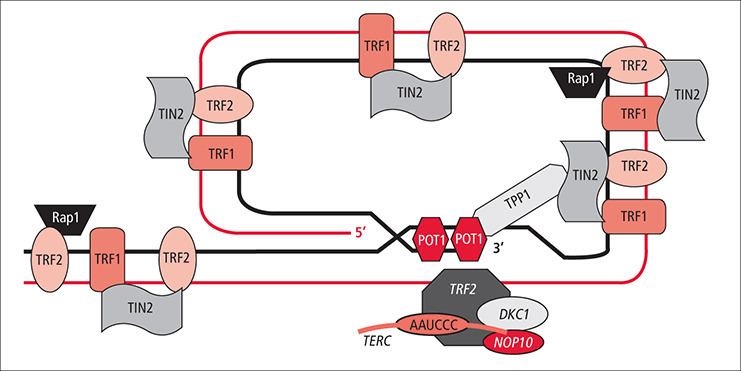 | ||
Shelterin (also called telosome) is a protein complex known to protect telomeres in many eukaryotes from DNA repair mechanisms, as well as regulate telomerase activity. In mammals and other eukaryotes, telomeric DNA consists of double- and single-stranded TTAGGG repeats and a single-stranded, G-rich overhang. Subunits of shelterin bind to these regions and induce the formation of a t-loop, a cap structure that deters DNA-damage-sensing machinery from mistakenly repairing telomeres. The absence of shelterin causes telomere uncapping and thereby activates damage-signaling pathways that may lead to non-homologous end joining (NHEJ), homology directed repair (HDR), senescence, or apoptosis.
Contents
Subunits
Shelterin has six subunits: TRF1, TRF2, POT1, RAP1, TIN2, and TPP1. They can operate in smaller subsets to regulate the length of or protect telomeres.
Repression of DNA repair mechanisms
There are two main DNA-damage-signaling pathways that shelterin represses: the ATR kinase pathway, blocked by POT1, and the ATM kinase pathway, blocked by TRF2. In the ATR kinase pathway, ATR and ATRIP sense the presence of single-stranded DNA and induce a phosphorylation cascade that leads to cell cycle arrest. To prevent this signal, POT1 "shelters" the single-stranded region of telomeric DNA. The ATM kinase pathway, which starts from ATM and other proteins sensing double strand breaks, similarly ends with cell cycle arrest. TRF2 may also hide the ends of telomeres, just as POT1 hides the single-stranded regions. Another theory proposes the blocking of the signal downstream. This will lead to a dynamic instability of the cells over time.
The structure of the t-loop may prevent NHEJ. For NHEJ to occur, the Ku heterodimer must be able to bind to the ends of the chromosome. Another theory offers the mechanism proposed earlier: TRF2 hides the ends of telomeres.
Species differences
At least four factors contribute to telomere maintenance in most eurkaryotes: telomerase, shelterin, TERRA and the CST Complex. Fission yeast (Schizosaccharomyces pombe) has a shelterin complex for protection and maintenance of telomeres, but in budding yeast (Saccharomyces cerevisiae) this function is performed by the CST Complex. For fission yeast, Rap1 and Pot1 are conserved, but Tpz1 is an ortholog of TPP1 and Taz1 is an ortholog of TRF1 and TRF2.
Plants contain a variety of telomere-protecting proteins which can resemble either shelterin or the CST Complex.
The fruit fly Drosophila melanogaster lacks both shelterin and telomerase, but instead uses retrotransposons to maintain telomeres.
Non-telomeric functions of shelterin proteins
TIN2 can localize to mitochondria where it promotes glycolysis.
RAP1 regulates transcription and affects NF-κB signaling.
